Learning Outcomes
After this course, learners will be able to:
- Describe changes in emotions related to masking for hearing-impaired people in 2021 compared to 2022.
- Compare perceived hearing ability, tinnitus, and hearing aid use in 2021 and 2022.
- Explain the Catch-22 of Covid-19.
Introduction
This follow-up study explores changes in hearing-impaired people’s experiences of Covid-19 restrictions between 2021 to 2022. Our initial investigation (Sjolander et al., 2022) asked hearing-impaired people living in Copenhagen, Denmark, and Chicago, United States of America, about their experiences with hearing impairment and Covid-19 restrictions. This survey included similar questions to those reported by Naylor et al. (2020), who sampled hearing-impaired people from Glasgow, Scotland during March 2020. Participants in the study by Naylor et al., (2020) reported greater levels of anxiety interacting with masked talkers than was observed in our initial study. However, as the same population did not participate in these two studies, differences may be related to the sample and not adaptation to Covid-19. This investigation includes the same participants as in the initial study (only the Copenhagen cohort), allowing us to explore changes in hearing impaired people’s experiences with Covid-19 over time.
Method
Participants and materials
Members of the GN Hearing test person database in Copenhagen, Denmark, were asked to complete a survey two times with about a year between. Data collection was completed between January-March 2021 and between February-March 2022. Covid-19 restrictions in Denmark, including wearing masks or shields as well as distancing, were lifted during the first quarter of 2022. This means that some of the responses were gathered after restrictions had ended, and thus, some reports will rely on recent memory. Three hundred forty-two people from the GN Hearing participant pool in Denmark were sent email invitations to complete the online survey using SurveyMonkey®. One hundred and seventy-four people completed the survey in both 2021 and in 2022, (response rate of 51%). Participants ages ranged from 29-98, with a mean age of 72.2 years (SD = 10.65).
The surveys covered five main topics: hearing perception and hearing aid use, tinnitus, communication, behavior, and emotions. The second survey included additional questions about Covid-status, as it was more common that people living in Copenhagen had tested positive for Covid-19 in 2022 compared to in 2021. In March 2021, around 200,000 people in Denmark had tested positive for Covid-19. By March 2022 nearly half of Denmark’s population (2.6 million people) had tested positive for Covid-19 (Worldometer 2022).
Table 1 in the appendix includes questions and response options.
Analysis
Normal distributions were confirmed visually using histograms. Values from the Likert-scale questions were used to determine mean questionnaire scores. Mean differences between the two times points were analyzed using paired-sample t-tests, excluding cases where no response was given, or the response was ‘not applicable.’
Results
Paired t-test results for all questions between 2021 and 2022 are provided in the table below. Findings are discussed in the following five sub-sections (1) hearing perception and hearing aid use, (2) tinnitus, (3), communication, (4) behavior, and (5) emotions.
Question | 2021 | 2022 | t | dof | p | Cohen’s d | |||
M | SD | M | SD | ||||||
Hearing perception and hearing aid use |
| ||||||||
How is your hearing when you do not use hearing aids? | 1.97 | 0.72 | 1.9 | 0.72 | 1.82 | 171 | .07 | 0.1 | |
Do you use hearing aids? | 1.93 | 0.25 | 1.94 | 0.23 | -0.82 | 171 | .42 | 0.05 | |
How is your hearing when you use hearing aids. | 3.68 | 0.89 | 3.69 | 0.81 | -0.2 | 153 | .84 | 0.02 | |
On an average day during the last week, how many hours did you wear your hearing aids? | 4.59 | 0.95 | 4.65 | 0.88 | -1.04 | 154 | .3 | 0.05 | |
Tinnitus | |||||||||
Do you suffer from tinnitus? | 1.85 | 0.85 | 1.81 | 0.83 | 1 | 156 | .32 | 0.04 | |
My tinnitus has gotten worse during covid-19. | 2.15 | 0.85 | 2.29 | 0.84 | -1.42 | 78 | .16 | 0.17 | |
Communication | |||||||||
It is hard to understand speech when the person I am speaking with is wearing a face mask. | 3.31 | 1.07 | 3.52 | 0.98 | -2.6 | 151 | .009** | 0.2 | |
When people speak to me at the recommended distance, it is hard to hear and understand them. | 3.61 | 0.96 | 3.38 | 1.03 | 3.08 | 167 | .002** | 0.23 | |
Behavior | |||||||||
During Covid-19 I have used my hearing aids less than I usually do. | 1.78 | 1.21 | 1.82 | 1.16 | -0.55 | 156 | .58 | 0.04 | |
How many conversations have you had over the past week where the speaker was wearing a face mask? | 2.92 | 1.1 | 3.46 | 1.12 | -5.19 | 171 | <.001*** | 0.47 | |
I use the telephone more now than I did before Covid-19. | 3.01 | 1.09 | 2.58 | 0.92 | 4.6 | 155 | <.001*** | 0.46 | |
I use video calls more now than I did before Covid-19. | 3.25 | 1.25 | 2.69 | 1.16 | 5.6 | 132 | <.001*** | 0.5 | |
Emotions | |||||||||
It is annoying to wear hearing aids and a face mask. | 3.94 | 1.14 | 4.23 | 1 | -2.8 | 156 | .006** | 0.27 | |
I am more worried now than before Covid-19 about what to do if I have a problem with my hearing aids or if I lose them. | 2.68 | 1.24 | 2.34 | 1.19 | 3.14 | 156 | .002** | 0.27 | |
It worries me to be in public places because I might have to speak to someone with a facemask. | 2.62 | 1.09 | 2.54 | 1.19 | 0.99 | 171 | .32 | 0.07 | |
It is a relief not to have to participate in social get togethers where I might not hear well. | 2.74 | 0.87 | 2.28 | 1.15 | 4.62 | 170 | <.001*** | 0.39 | |
I am less bothered by my hearing loss now than before Covid-19 | 2.22 | 0.87 | 2.15 | 0.9 | 0.69 | 156 | 0.49 | 0.07 | |
Table 1. Results of paired t-test for survey questions in 2021 and 2022. ** p <.01 *** p<.001
Questionnaire Section 1: Hearing Perception and Use of Hearing Aids
There is no significant difference in hearing perception and use of hearing aids among participants in 2021 compared to 2022 (see Table 1). Distributions for the questions about hearing perception and the use of hearing aids are shown in figure 1. Most participants in 2021 and 2022 reported their unaided hearing as poor or very poor (Figure 1A). Over 80% of participants reported using hearing aids (Figure 1B), and most people reported wearing their hearing aids for more than 8 hours per day (Figure 1E). The most common hearing aid style is the receiver-in-ear style hearing aid, with three-quarters of participants wearing this style of hearing aid (Figure 1C). Participants most commonly self-reported their hearing as good when using hearing aids (Figure 1D).
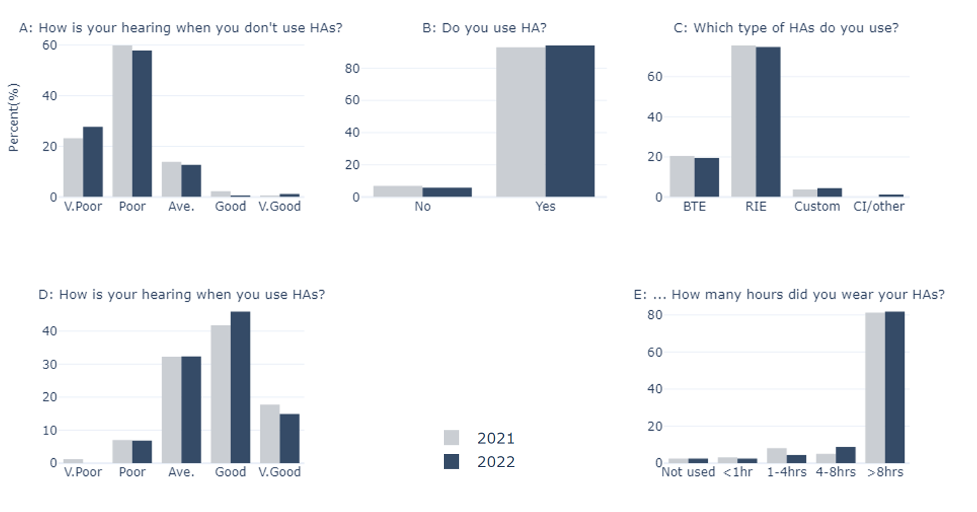
Figure 1. Participant responses to questions relating to information about hearing loss and hearing aids (grey = 2021; navy = 2022). A, how is your hearing when you do not use hearing aids- B, do you use hearing aids. C, which type of hearing aids do you use. D, how is your hearing when you use hearing aids. E, on an average day during the last week, how many hours did you wear your hearing aids.
Questionnaire Section 2: Tinnitus
No significant change in the report of tinnitus or worsening of tinnitus was found (see Table 1 and Figure 2). In 2022, 55% of participants reported that they suffered from tinnitus sometimes or often, and only 3% of participants reported that their tinnitus had become worse during the period of Covid-19.

Figure 2. Participant responses to questions relating to tinnitus (grey = 2021 responses; navy = 2022 responses). A, do you suffer from tinnitus. B, my tinnitus has gotten worse during covid-19.
Questionnaire Section 3: Communication
People reported significantly more difficulty understanding speech when the speaker was wearing a mask in 2022 compared to 2021 (t(151) = -2.651, p = .009). Conversely, they reported significantly less difficulty understanding speech when the speaker was talking at the recommended safe distance (6ft) in 2022 as compared to 2021 (t(167) = 3.079, p = .002). Figure 3 shows the distribution of responses for the questions related to communication experiences.
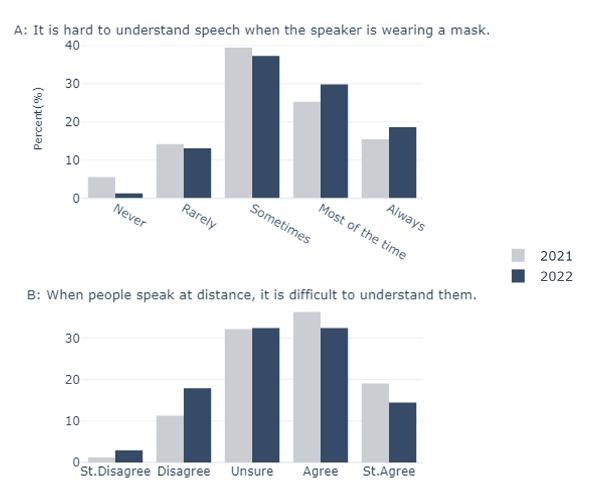
Figure 3. Participant responses to questions relating to communication experiences (grey = 2021 responses; navy = 2022 responses). A, it is hard to understand speech when the person I am speaking with is wearing a face mask. B, when people speak to me at the recommended distance, it is hard to hear and understand them.
Questionnaire Section 4: Behavior
Less than 10% of participants reported using their hearing aids less than what they normally did before Covid-19 (figure 4A). This finding was consistent between 2021 and 2022 (t(156) = -0.55, p = .583) In 2022 people reported having significantly more conversations with people wearing a mask compared to 2021 (t(171) = -5.19, p < .000; figure 4B). In 2021 people reported a significantly greater increase in telephone and video calls than in 2022 (t(155) = 4.615, p < .000) (t(132) = 5.592, p < .000; figure 4C, 4D). Note both surveys asked participants to compare prior to the Covid-19 pandemic.
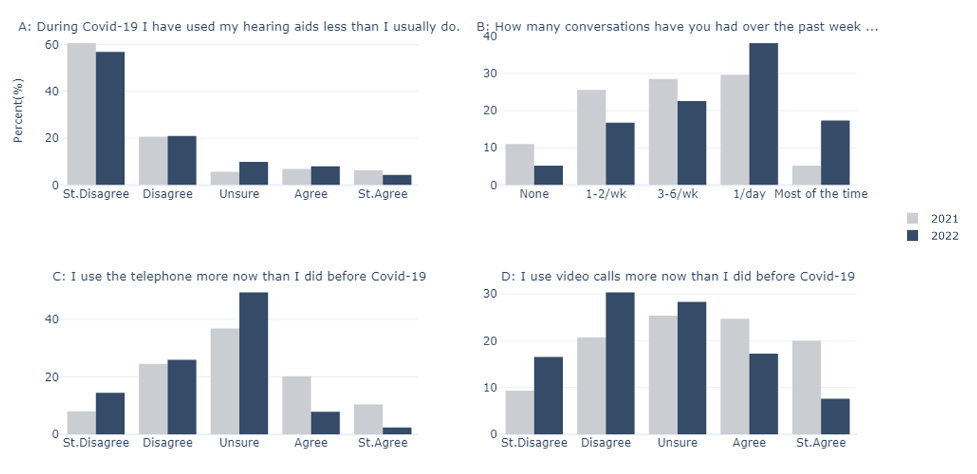
Figure 4. Participant responses related to changes in behavior during covid-19 (grey = 2021 responses, navy = 2022 responses). A, during Covid-19 I have used my hearing aids less than I usually do. B, how many conversations have you had over the past week where the speaker was wearing a face mask. C, I use the telephone more now than I did before Covid-19. D, I use video calls more now than I did before Covid-19.
Questionnaire Section 5: Emotions
Participants were significantly more annoyed about wearing a mask and a hearing aid in 2022 than they were in 2021 t(156) = -2.809, p = .006 (see figure 5A). In 2022 they also reported being significantly less worried about what to do if their hearing aid broke (t(156) = 3.138, p = .002; see figure 5B). Participants were significantly less likely to report being relieved to not need to attend social events where they might hear poorly in 2022 compared to in 2021 (t(170) = 4.616, p < .000.) Almost one quarter of participants agreed or strongly agreed they were relieved not to have to participate in events where they might hear poorly in 2021, this decreased to 15% of participants in 2022 (see figure 5D).
In 2022 approximately a quarter of participants reported being worried about going into public places where they might have to speak to someone wearing a mask; similar results were found in 2021 (see figure 5C). Also, there was no significant change in how bothered people were about their hearing loss (see figure 5E) over time with around 5% agreeing or strongly agreeing that they were less bothered by their hearing loss now than before Covid-19.
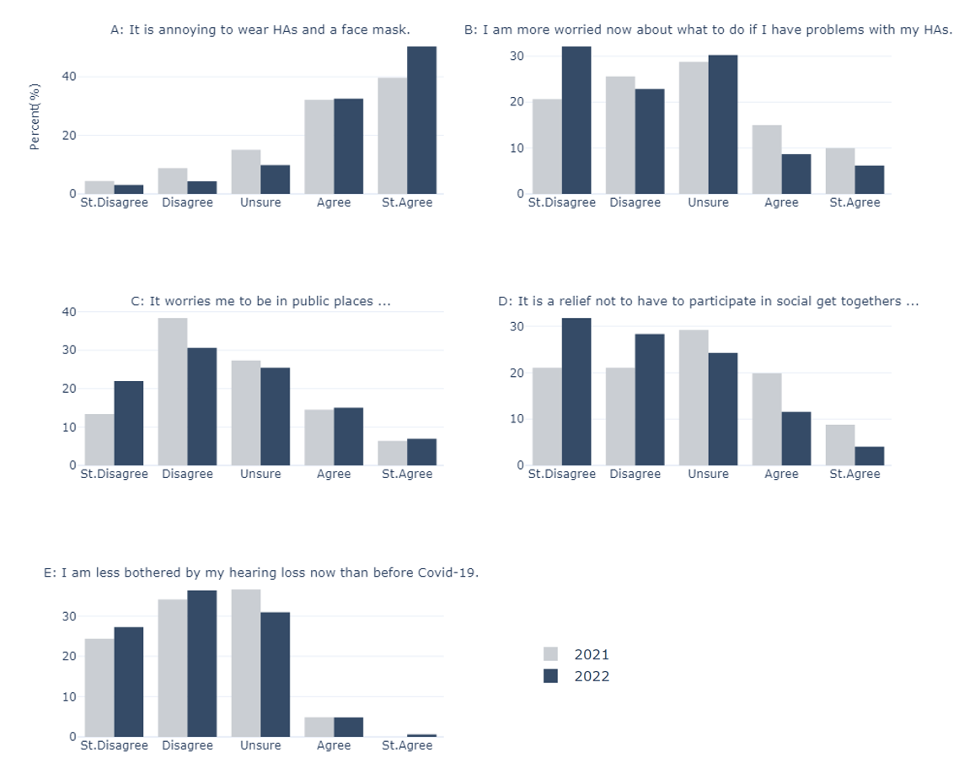
Figure 5. Participant responses related to emotion driven questions (grey = 2021 responses, navy = 2022 responses). A, it is annoying to wear hearing aids and a face mask. B, I am more worried now than before Covid-19 about what to do if I have a problem with my hearing aids or if I lose them. C, it worries me to be in public places because I might have to speak to someone with a facemask. D, it is a relief not to have to participate in social get-togethers where I might not hear well. E, I am less bothered by my hearing loss now than before Covid-19
Covid Status
In 2022 only, participants were asked about Covid-19 infection status, and participants who reported testing positive for Covid-19 were also asked about hearing/speech understand changes since they tested positive for Covid-19. Approximately one-third (n = 54) of participants reported having tested positive for Covid-19. This is a lower rate than the national average at the same time and likely reflects the older population included in this survey, as older people were less likely to test positive for Covid-19 (Statens Serum Institute, 2022). Of the participants who reported having tested positive for Covid-19, 90% reported no changes in hearing/speech understanding, 6% reported that their hearing/speech understanding had changed since testing positive for covid and 4% chose don’t know/don’t want to answer.
A Pearson Correlation analysis explored the relationship between covid status and response questions. There was a significant mild positive correlation between having had covid and tinnitus becoming worse, r(161) = .17, p = .034. Saunders et al. (2022) found a similar increase in self-reported auditory symptoms for Covid positive or Covid probable participants. No other significant associations were identified (see Table 2 in appendix).
Conclusions
Overall, in 2022, more people were fed up with restrictions and masking than in 2021, showing that people do not necessarily become more accepting of restrictions just because they become more accustomed to them. Self-report measures not related to Covid-19 remained consistent, such as rating of severity of own hearing loss and hearing aid use. In 2022, annoyance with masks and self-reported difficulty understanding masked speech increased. More difficulty understanding speech may relate to more masked conversations in 2022 than in 2021, people reported significantly more masked conversations in 2022 and more desire to go out. At the time of sending the second survey, Danish vaccine status was around 80% compared to around 10% at the time of sending out the 2021 survey, this may have impacted people’s comfort of being around other people (Statens Serum Institut, 2022).
Another indication in the survey that people were more comfortable being out and about was the significant decrease in worry about what to do if something happened to the hearing aids. Furthermore, in 2022, significantly fewer participants reported relief about not having to attend social gatherings where they might hear poorly; another indication that people do not want to accept a “new normal” and the catch-22 of Covid-19 and masking. People want to socialize, to socialize they need masks, with masks socializing is difficult; this is the catch-22 of covid-19 (Figure 6).
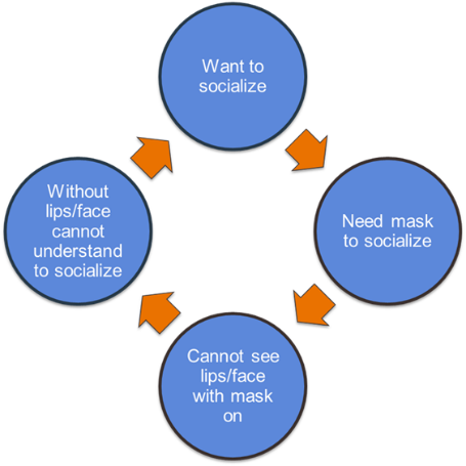
Figure 6. Covid in 2022 is a catch-22 for people with hearing loss.
Below is a snippet of the poem “2020 Unmasked” by Carly Sygrove that describes this dilemma of masks and socialization.
"My life is one without full sound, even before the mask.
I fathom meaning from snippets of words, using lips to guide the way.
But these masks, they. Stopped, Me. In. My. Tracks.
I can’t see your lips, their movement and shapes, to give a clue to what you say.
Concealed expressions on covered faces. More concentration needed. I’m tired, drained." (2021)
References
Chirakkal, P., Al Hail, A. N., Zada, N., & Vijayakumar, D. S. (2021). COVID-19 and tinnitus. Ear, Nose, & Throat Journal, 100(2), 160S–162S. https://doi.org/10.1177/0145561320974849
Naylor, G., Burke, L., & Holman, J. (2020). Covid-19 lockdown affects hearing disability and handicap in diverse ways: a rapid online survey study. Ear and Hearing, 41(6), 1442-1449. DOI: 10.1097/AUD.0000000000000948.
Danish Government, National Communicatons Partnership. (2022, January 26). No more corona restrictions from February 1st. coronasmitte.dk
Saunders, G. H., Beukes, E., Uus, K., Armitage, C. J., Kelly, J., & Munro, K. J. (2022). Shedding light on SARS-CoV-2, COVID-19, COVID-19 vaccination, and auditory symptoms: causality or spurious conjunction? Frontiers in Public Health, 10,837513. https://doi.org/10.3389/fpubh.2022.837513
Sjolander, M.L., Møller, K.N. & Bott, A. (2022). Snapshot of the impact of covid-19 on people with hearing loss in Chicago, Illinois and Copenhagen, Denmark. AudiologyOnline, Article 28125. Available at www.audiologyonline.com
Statens Serum Institut, (2022, September 16). Vaccine roll-out numbers Denmark. https://en.ssi.dk/covid-19
Worldometer. (2022, November 10). https://www.worldometers.info/coronavirus/country/denmark/
Sygrove, C. A. (2021, April 2). 2020 Unmasked. ENT & audiology news. https://www.entandaudiologynews.com/news/post/2020-unmasked-by-carly-sygrove
Appendix
Survey question | Conditions | Answer options (numerical value) |
How is your hearing when you do not use hearing aids | None | Very good (5) Good (4) Average (3) Poor (2) Very poor (1) |
Do you use HAs | None | No (1) I use two hearing aids (2) I use one hearing aid (2) |
Which type of HA(s) do you use | Conditioned by yes to HA use | BTE RIE In-the-ear Cochlear implant/other |
How is your hearing when you use HAs | Conditioned by yes to HA use | Very good (5) Good (4) Average (3) Poor (2) Very poor (1) |
On an average day during the last week, how many hours did you wear HAs | Conditioned by yes to HA use | I have not used them (1) Under one hour per day (2) 1-4 hours per day (3) 4-8 hours per day (4) More than 8 hours per day (5) |
During Covid-19 I have used my HAs less than I usually do | Conditioned by yes to HA use | Strongly agree (5) Agree (4) Neither agree nor disagree (3) Disagree (2) Strongly disagree (1) |
It is annoying to wear HAs as well as a face mask | Conditioned by yes to HA use | Strongly agree (5) Agree (4) Neither agree nor disagree (3) Disagree (2) Strongly disagree (1) |
I am more worried now than before Covid-19, about what to do if I have a problem with my HAs or if I lose them | Conditioned by yes to HA use | Strongly agree (5) Agree (4) Neither agree nor disagree (3) Disagree (2) Strongly disagree (1) |
Do you suffer from tinnitus | None | Yes, often (3) Sometimes (2) No (1) |
My tinnitus has gotten worse during Covid-19 | Conditioned by yes to tinnitus | Strongly agree (5) Agree (4) Neither agree nor disagree (3) Disagree (2) Strongly disagree (1) |
How many conversations have you had over the past week where the speaker was wearing a face mask | None | No conversations the past week (1) 1-2 conversations per week (2) 3-6 conversations per week (3) At least once per day (4) Most of the day most days (5) |
It is hard to understand speech when the person I am speaking with is wearing a mask (if you use hearing aids, please answer when listening with hearing aids) | None | Always (5) Most of the time (4) Sometimes (3) Rarely (2) Never (1) |
When people speak to me at the recommended distance (6 feet) it is difficult to hear and understand them | None | Strongly agree (5) Agree (4) Neither agree nor disagree (3) Disagree (2) Strongly disagree (1) |
It worries me to be in public places (e.g. the supermarket) because I might have to speak to someone with a face mask | None | Strongly agree (5) Agree (4) Neither agree nor disagree (3) Disagree (2) Strongly disagree (1) |
It is a relief not to have to participate in social get-togethers where I might not hear very well | None | Strongly agree (5) Agree (4) Neither agree nor disagree (3) Disagree (2) Strongly disagree (1) |
I use the telephone more now than I did before Covid-19 | None | Strongly agree (5) Agree (4) Neither agree nor disagree (3) Disagree (2) Strongly disagree (1) |
I use video calls now more than I did before Covid-19 | None | Strongly agree (5) Agree (4) Neither agree nor disagree (3) Disagree (2) Strongly disagree (1) |
I am less bothered by my hearing loss now than before covid-19 | None | Strongly agree (5) Agree (4) Neither agree nor disagree (3) Disagree (2) Strongly disagree (1) |
Have you tested positive for Covid-19 | Only asked in 2022 survey | No (1) Yes (2) Do not want to answer (removed) |
Has your hearing/speech understand changed since you tested positive for Covid-19? | Conditioned by yes to having tested positive for covid. |
|
Table 2. Quantitative questions in the survey, conditions related to question, answer options and the numerical value of an answer
Question | Covid-status |
What is your age (years)? | -0.099 |
I have had covid before? | 1.000 |
How is your hearing when you do not use hearing aids? | 0.075 |
Do you use hearing aids? | -0.102 |
How is your hearing when you use hearing aids? | 0.072 |
On an average day during the last week, how many hours did you wear HAs? | -0.105 |
During covid-19 I have used my HAs less than I usually do? | 0.044 |
It is annoying to wear HAs and a mask? | -0.039 |
I am more worried now than before Covid-19, about what to do if I lose my HAs? | -0.041 |
I suffer from tinnitus? | 0.167* |
My tinnitus has gotten worse during Covid-19? | -0.010 |
How many conversations have you had over the past week where the speaker was wearing a face mask? | -0.099 |
It is hard to understand speech when the person I am speaking with is wearing a mask? | -0.066 |
When people speak to me at the recommended distance (6 feet) it is difficult to hear and understand them? | -0.071 |
It worries me to be in public places, because I might have to speak to someone with a face mask? | -0.020 |
It is a relief not to have to participate in social get-togethers where I might not hear very well? | -0.059 |
I use the telephone more now than I did before covid-19? | 0.013 |
I use video calls now more than I did before covid-19? | 0.076 |
I am less bothered by my hearing loss now than before covid-19. | 0.105 |
Table 3. Correlation between all questions and Covid status. * p= <.05 Note: covid status was rated as 0 = ‘Not having covid’ or 1 = ‘had covid’
Citation
Sjolander, M.L., Møller, K.N. & Bott, A. (2022). Covid and masking, a catch 22. AudiologyOnline, Article 28441. Available at www.audiologyonline.com




